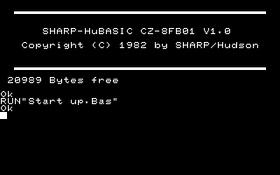Sharp X1
| Sharp X1 | |
|---|---|
 
|
|
| Manufacturer | Sharp |
| Type | Home computers |
| publication | 1982 |
| End of production | 1988 |
| Factory price | 155,000 yen |
| processor | Zilog Z80 |
| random access memory | 64 kB |
| graphic | 320 × 200/640 × 200 |
| Sound | AY-3-8910 or Yamaha YM2151 |
| Disk | Compact cassette , floppy disk |
| operating system | CP / M |
| predecessor | Sharp MZ |
| successor | X68000 |
Sharp X1 ( エ ッ ク ス ワ ン Ekkusuwan ) is the name of a series of home computers made by the Japanese manufacturer Sharp from 1982 to 1988. The series is based on the Zilog Z80 microprocessor .
history
In the end trains of the MZ80 series, Sharp's TV division launched the X1 (CZ-800C) from 1982 onwards. This first variant has similarities to the MZ80 variant of the MZ2000, but is not compatible with it. The most noticeable feature was the red housing color. There are also connections to radio or TV receivers. The hardware consisted of a Z80A CPU clocked at 4 MHz with 64 kB RAM, 4 kB VRAM (maximum expandable to 48 kB) and a graphic resolution of 640 × 200 pixels. A cassette drive was used as mass storage device.
According to Sharp's clean computer concept, which was also used in the MZ series, the computer does not have an integrated BASIC-ROM or any other operating system. Instead, the operating system had to be read in via a data carrier (tape basic, disk basic). This gave the user a free choice of the operating system that was loaded into the main memory at startup. In return, this delayed the start time until the device was fully operational. The device was designed as a multimedia system and, in conjunction with the X1 monitor, could display text or graphics over the television picture.
The X1 was primarily in competition with NEC's PC-8801 . In 1984 Sharp released the X1 turbo with a higher resolution of 640 × 400 pixels. In 1986 the X1 turbo Z followed with an analog RGB monitor with 4096 colors. The last model to appear in 1987 was the X1 twin, with an integrated PC engine game console , including a HuCard reader. The user could switch between the two systems at any time, but a reciprocal exchange of data between the two systems was not possible. The X1 twin is also not compatible with the hardware additions to the game console that were published in the following years.
In 1987 a technical successor appeared with the X68000 , and in 1988 the X1 series was finally discontinued.
Web links
Individual evidence
- ↑ Sharp X1 (CZ-800C). In: Duke Gozers Computer History Corner. Retrieved June 17, 2019 .
- ↑ X1 (CZ-800C). In: Old-Computers.com: The Museum. Retrieved June 17, 2019 .
- ↑ Bogdan Ion Purcaru: Games vs. Hardware. The History of PC video games: The 80's . March 13, 2014, p. 52–53 ( google.de [accessed June 17, 2019]).